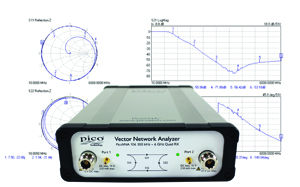Pico Technology has applied its expertise in compact USB instrumentation, combined with its experience with high-performance sampling oscilloscopes and time domain reflectometry, to bring you a outstanding value in a high-quality, low-cost vector network analyzer.
If you work with high-speed data, communications or computing, you often need to characterize high-frequency interfaces, devices, multi-path interconnect and antennas. Today’s engineers and systems integrators do not have time to become microwave specialists. They need a straightforward, accurate, fast, portable and low-cost measurement instrument, and ideally one that can support developing applications such as 5G, IoT, radar and tissue and materials imaging.
The PicoVNA 106 is an all-new, U.K.-designed, USB-controlled, professional and laboratory-grade 300 kHz to 6 GHz vector network analyzer of unprecedented performance, portability and affordability. Despite its small size and low cost, the instrument boasts a full-function, minimal-error, "Quad RX" four-receiver architecture. This supports both 8- and 12-term calibration without the uncorrectable switching errors, delays and unreliability of traditional three-receiver designs. The instrument supports convenient calibration methods such as "enhanced isolation correction" and "unknown thru".
The PicoVNA 106 has exceptional dynamic range of up to 118 dB at 10 Hz and only 0.005 dB RMS trace noise at its maximum bandwidth of 140 kHz. It can gather all four S-parameters at just 190 microseconds per frequency point; in other words, a 500 point 2-port S2P Touchstone file, compatible with test, math, view and EDA simulation tools, in less than a tenth of a second! This performance compares with other full-function vector network analyzers at more than four times the cost; in fact, the PicoVNA 106 is even cost-effective as a high-dynamic-range scalar network analyzer or a single-port vector reflectometer. This breakthrough solution is affordable for classrooms, small businesses and even amateur workshops, yet able to meet the needs of the microwave laboratory and expert. Pico have even included bias-Ts for the convenient injection of a bias or test stimulus.
The PicoVNA 106’s small size, weight and cost, and high performance suit it to field service, installation test, embedded and training applications. Its remote automation interface suits it to test automation, perhaps as a reflectometry or transmission measurement core for embedded roles. Example test environments are broadband interconnect, cable and harness, antenna, component or subsystem assembly, installation and fault over life, in manufacture, calibration, distribution and service industries.
The PicoVNA 106 is supplied with Microsoft Windows software to support a full range of plot formats for scalar and vector view of dual or single-port parameters. These can be saved or exported in various graphic and tabular formats including Touchstone. The software includes, at no additional cost, Fourier transformation to the time domain, adding convenient distance-to-fault capability and pulse response determination. In all cases nominal impedance transformation (10 to 200 Ω) is available, mathematically or using port matching pads, with limit tests on the Cartesian plot formats.
Unwanted measurement contributions from feed lines, probes or test jigs can be eliminated using manual or automatic reference plane offset including, when required, fully independent offset for each S-parameter. Alternatively, independent networks can be embedded or de-embedded at each port from a Touchstone representation of each, measured or synthesized. Unusually for any vector network analyzer, embedding or de-embedding is interpolated when measurement and network datasets do not share the same frequency points.
Pico have also included in their free-of-charge PicoVNA 2 software two utilities to tackle gain compression (P1dB) and AM to PM. Both of these use a port power sweep at each test frequency. Both measures are extracted using second-order interpolation.
Calibration standards and interconnect for vector network analysis can dominate both performance and costs. Pico offers PC3.5 and SMA, male and female test ports via flexible and flex-formable, phase- and flatness-stable test leads. Four mating calibration standards, with traceable data, are assembled into convenient male and female SOLT housings. Like the test leads, the SMA and PC3.5 calibration standards all use robust, high-precision stainless steel connectors.

